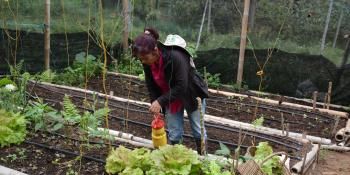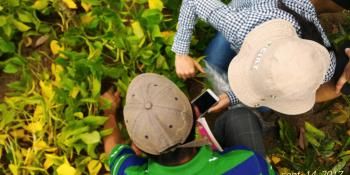Mangroves shield communities from typhoons, storm surges

Coastal communities improve their climate resilience by planting mangroves as protection from strong waves and storm surges due to typhoons.
PHILIPPINES—Because of climate change, stronger typhoons are expected in the coming years. According to the Fifth Assessment Report of the International Panel on Climate Change (IPCC), it is likely that although the number of typhoons occurring will stay the same, the intensity of these storms will increase.
To the Philippines, an archipelagic country that experiences an average of 20 typhoons a year, this is a concern. Many of its communities are found on the coasts of islands facing the Pacific. It is thus important for these coastal communities to improve their adaptation strategies and prepare for extreme climatic events.
Replanting mangrove stands in Guinayangan
The International Institute of Rural Reconstruction (IIRR), in collaboration with the local government and fisherfolk organizations of the municipality of Guinayangan in the Philippines, is implementing a mangrove reforestation project in eight coastal villages. Titled ‘Establishing Coastal Bio-Shield in Guinayangan, Quezon’, the activity is part of the CGIAR Research Program on Climate Change, Agriculture and Food Security in Southeast Asia (CCAFS SEA) project on Climate-Smart Villages (CSVs) implemented by IIRR.
Mangroves offer many benefits to coastal communities. They provide sources of food and income, while also providing protection from strong waves and storm surges experienced during typhoons. Although similar initiatives have been conducted by government and non-government organizations in Guinayangan, IIRR aims to differentiate their initiative by identifying the appropriate species to be planted in the right locations.
Sustaining the efforts with community involvement
In 2014, Guinayangan participated in the Guinness World Record attempt to plant three million mangroves in one day in Quezon province. While it was initially successful, the mangroves planted for this attempt eventually died. Well thought out strategies thus ensure that the planted mangroves would survive and continuously provide benefits to the community.
Learning from the previous initiatives, IIRR is working closely with the Municipal Environment and Natural Resources Office (MENRO), Disaster Risk Reduction and Management Office (DRRMO), Municipal Agriculture Office (MAO), and Municipal Fisherfolk Federation to mobilize village-level fisherfolk organizations to participate in the project. Eight barangays (villages) aim to plant a total of 28,000 seedlings for the whole project or 3,500 seedlings per community.
The reforestation project is implemented through an incentive scheme. Wildlings collected from existing mangrove stand in the barangays of Aloneros and Dancalan Caimawan are brought to nurseries established and maintained by the fisherfolk. They are paid PHP 2.00 (USD 0.04) per seedling that is successfully hardened. The wildlings are then transplanted to the reforestation areas, whereupon the fisherfolk are paid PHP 2.00 again. For each seedling that survives from the time it is transplanted until the end of December 2015, the fisherfolk organizations are paid another PHP 2.00.
Aside from involving the local fisherfolk organizations through the incentive scheme, other locals knowledgeable on mangroves are also involved in the project. The Municipal Disaster Risk Reduction Management Officer had already served as a coastal resource management officer for a similar project. One of the fisherfolk leaders was also trained in nursery management and mangroves plantation forest establishment and management. They provide technical guidance to the activities of the fisherfolk organizations.
IIRR and its partners also consulted with scientists, including Dr Jurgenne Primavera, a mangroves expert from the International Union for Conservation of Nature (IUCN). The project team hopes this start-up activity will later lead to a community-based coastal resource management program in the municipality and further improve the climate resilience of the coastal communities in Guinayangan.
Read more:
- Linking pink shrimps, green mangroves and blue carbon
- Act now for farmers’ futures
- Big Facts: Focus on Adaptation
Amy Cruz is the junior communications specialist for the World Agroforestry Centre Philippines. She is also a communication consultant with the CCAFS SEA program.



